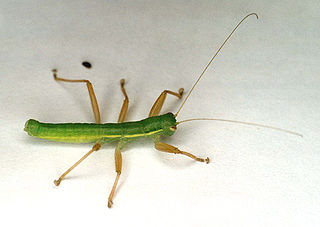
Mantophasmatidae is a family of carnivorous wingless insects within the order Notoptera, which was discovered in Africa in 2001. Originally, the group was regarded as an order in its own right, and named Mantophasmatodea, but, using recent evidence indicating a sister group relationship with Grylloblattidae, Arillo and Engel have combined the two groups into a single order, Notoptera.

Chiniquodon is an extinct genus of carnivorous cynodonts, which lived during the Late Triassic (Carnian) in South America and Africa. Chiniquodon was closely related to the genus Aleodon, and close to the ancestry of mammals.

Sagittariidae is a family of raptor with one living species—the secretarybird native to Africa. This single extant species, has effected the fossil record of the group by ‘pulling’ the temporal range of the family to the present, an artifact called the Pull of the Recent.

Hoodia is a genus of flowering plants in the family Apocynaceae, under the subfamily Asclepiadoideae, native to Southern Africa.

Velvet spiders are a small group of spiders almost entirely limited to the Old World, with exception of a few species known from Brazil. In Europe some are commonly called the ladybird spiders

The gemsbok or South African oryx is a large antelope in the genus Oryx. It is native to the extremely dry, arid regions of Southern Africa; notably, the Kalahari and Namib desert. Some authorities formerly classified the East African oryx, or beisa oryx, as a subspecies.

Nuttalliella namaqua is a tick found in southern Africa from Tanzania to Namibia and South Africa, which is placed in its own family, Nuttalliellidae. It can be distinguished from ixodid ticks and argasid ticks by a combination of characteristics including the position of the stigmata, lack of setae, strongly corrugated integument, and form of the fenestrated plates. It is the most basal lineage of ticks.

Strumaria is a genus of African plants in Amaryllis family, subfamily Amaryllidoideae. The genus is known in nature only from South Africa, Lesotho and Namibia. Almost all species flower in the autumn and are cultivated as ornamental bulbous plants.

Ysengrinia is an extinct genus of carnivoran in the family Amphicyonidae (beardogs), which lived in Europe, Asia, and North America during the Early Miocene. It was also reported from Egypt and Namibia, but this material has been reassigned to other genera of beardogs.
Megapedetes is a genus of fossil rodents related to the springhare and other species of the genus Pedetes, with which it forms the family Pedetidae. At least four species are known, which ranged through Africa, southwestern Asia, and southeastern Europe from the Miocene to the Pliocene. The genus was larger than Pedetes.

Clinus superciliosus, the Super klipfish or Highfin klipfish, is a species of clinid that occurs in subtropical waters of the Atlantic Ocean from northern Namibia to the Kei River in South Africa where it can be found in the subtidal and intertidal zones. This species can reach a maximum length of 30 centimetres (12 in) TL. This species feeds on benthic crustaceans including amphipods, isopods and crabs; sea urchins; gastropods; polychaete worms and other fishes.

Kewa is a genus of flowering plants, consisting of eight species of succulent sub-woody plants, native to eastern and southern Africa, including Saint Helena and Madagascar. These are small shrubs or herbs that form cushions and have edible, acid-tasting leaves. Kewa is the only genus in the family Kewaceae.

Karusasaurus, commonly known as Karusa lizards, is a genus of lizards in the family Cordylidae.

Hexophthalma is a genus of spiders in the family Sicariidae. Although the genus was originally erected in 1878, it was merged into the genus Sicarius in the 1890s, and remained unused until revived in 2017, when it was discovered that the African species then placed in Sicarius were distinct. The English name six-eyed sand spiders is used for members of the genus, particularly Hexophthalma hahni. Species in the genus have necrotic (dermonecrotic) venom, and can potentially cause serious or even life-threatening wounds.
Homalocnemis is a genus of flies which is placed in a family of its own, the Homalocnemiidae. There are about seven species in the genus found in the Afrotropical, Neotropical, and Australasian regions, suggestive of a Gondwanan origin. The genus was formerly considered a primitive empidoid and placed variously in the Hybotidae or in the empidid subfamily Brachystomatinae. They are recognized by their wing venation which includes a long anal cell and a long basal segment of the antennal style.
Scelodonta albidovittata is a species of leaf beetle from Namibia, Tanzania, Sudan, the Democratic Republic of the Congo and Rwanda, described by Joseph Sugar Baly in 1877.
Pachyphasma is a genus of insects in the family Mantophasmatidae. It is a monotypic genus consisting of the species Pachyphasma brandbergense.
Meroplius is a genus of flies in the family Sepsidae.
Diamantofelis is an extinct genus of felids that lived in what is now Namibia during the Early Miocene. It contains a single species, Diamantofelis ferox.
Namafelis is an extinct genus of felids that lived in what is now Namibia during the Early Miocene. It contains a single species, Namafelis minor. Closely related to Diamantofelis, it is of “Pseudaelurus-grade”, and therefore a rather basal member of the cat family.












